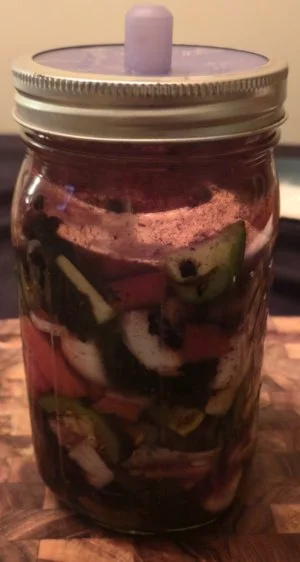Fermented Blackberry Chipotle Hot Sauce
Ingredients
For the ferment
2 cups/300 g fresh blackberries
½ cup/100 g chopped red red onion or shallot
½ cup/100 g chopped red bell pepper (optional)
2-3 jalapenos or other spicy peppers (about 40-60g )
4 cloves garlic, peeled and smashed (about 20g)
Brine (2.5% salt solution)
25g/1 Tbsp+2 tsp non-iodized salt
4 cup filtered water
After Fermentation (Blending)
1-3 chipotle peppers in adobo sauce (canned), plus some sauce
60-80 ml apple cider vinegar (¼–⅓ cup )
~30 ml/2 Tbsp fresh lime juice (about 1 lime)
21-41 mg/1-2 Tbsp honey or other sweetener (optional)
fermented brine (from the jar) — start with less, add more to thin if needed (about 100-300 ml)
Equipment
1-2 quart-size mason jars
Fermentation weights or small ziplock bags with brine
Fermentation lids or breathable covers
Blender
Fine mesh strainer (optional but recommended)
Bottles or jars for storage
Instructions
Wash all fresh ingredients
Chop all fresh ingredients and divide between jars
Dissolve salt in water and pour into jars to submerge all ingredients
Add fermentation weights to submerge solids below brine.
Cover with fermentation lid or cloth
Fermentation
Store jars at room temp (65–75°F / 18–24°C) for 5–10 days.
Watch for bubbles, cloudiness, and tangy aroma.
Make sure everything stays submerged. Skim off any white yeast if it appears.
The mixture may get cloudy, and that is fine
It will produce a but of an odor, tangy and kind of funky
If it gets mold in it or produces a putrid or rancid odor, discard
Blend
After fermentation, transfer solids and about 1–1¼ cups of brine to a blender.
Add chipotles, adobo sauce, vinegar, lime juice, and optional honey.
Blend until smooth and creamy. Strain for a silky texture (optional but recommended. Blackberry seeds are gritty).
Storage
Transfer to bottles or jars
Refrigerate for up to 3 months
Can be made shelf stable by water bath canning, but it is important to monitor the PH. (notes below)
Still reading? Here’s the nerdy stuff
I think everyone is annoyed by recipe blogs that block the actual recipe with walls of text, tales of the glory of summer and sweet richness of berries. That being said, there’s a reason the text is there, it helps funnel activity to the blog, and increases engagement time, which help with the google algortithms, so I need to include this sort of thing. I am going to include various suggestions, faqs, and science below the recipes.
Tips for Making Fermented Hot Sauce
The important part of this recipe for food safety is the salinity of the brine. In terms of vegetables and fruit, there is considerable room to experiment.
Try some of the following:
Chilies (Use a mix of fresh and/or dried for balance)
SerranO
Fresno
Thai chili (very hot)
Habanero or Scotch Bonnet (fruitier, intense)
Guajillo (earthy, mild–medium)
Pasilla
Smoked paprika (as a flavor booster post-ferment)
Acidifiers & Flavor Enhancers (After Ferment during blending)
White wine vinegar
Lime or lemon juice
Tamarind paste (tangy depth)
Balsamic vinegar (for dark fruit-based sauces)\
Miso paste (tiny amount for body/umami)
Herbs & Spices (Flavor Accents)
Cumin
Coriander
Black pepper
Fresh herbs: cilantro, thyme, oregano, mint
Dried herbs: Mexican oregano, bay leaf (during ferment)
Fruits (Try two or more for complexity)
Cherries
Habanero peppers
Raspberries
Peaches
Figs
Roasted red grapes
Aromatics & Vegetables (Depth + Ferment Support)
Garlic (essential!)
Roasted sweet peppers (for smoke/body)
Carrot (natural sweetness)
Celery or fennel bulb (subtle, herbal)
Roasted corn kernels (sweet-smoky twist)
Sweeteners (Add during blending if too sour)
Honey
Maple syrup
Brown sugar
Agave
Molasses (pairs well with smoky peppers)
How to Ferment Hot Sauce Safely
Use the Right Salt Ratio
Salt helps inhibit harmful bacteria while allowing good bacteria (like Lactobacillus) to thrive.
Use a 2%–3% brine solution by weight:
That’s 20–30 grams of salt per 1 liter of water,
Use non-iodized salt like sea salt or kosher salt.
2. Keep Everything Submerged
Exposing ingredients to air can cause mold or spoilage.
Use a fermentation weight or clean glass to press solids below the brine
If using jars, fill a small ziplock bag with brine and place it on top as a weight
Remember: “Under the brine, doing fine.”
3. Use Clean Jars and Hands
Sterilizing isn't required, but clean gear helps prevent contamination.
Wash jars with hot soapy water or run through the dishwasher
Use clean hands or gloves when packing ingredients
4. Watch for the Right Signs of Fermentation
Healthy fermentation looks like:
Bubbling after 1–2 days
A cloudy brine
A slightly sour, tangy smell (like pickles)
Avoid:
Fuzzy mold (especially blue, green, or black)
Rotten or slimy smells
White film (kahm yeast) is usually harmless — just skim it off.
5. Store at the Right Temperature
Fermentation works best at 65–75°F (18–24°C).
Too cold? Ferment will be slow
Too warm? It may ferment too fast or spoil
6. Blend & Refrigerate or Can
After fermentation:
Blend your sauce
Store in the fridge (lasts 2–3 months), or
Heat and water-bath can it if you want it shelf-stable
Check the pH if you're canning — it should be below 4.0. Otherwise botulism could be a concern
Botulism cannot grow in an acidic environment
Summary: Key Safety Tips for Fermenting Hot Sauce
Use a clean jar
Use a 2–3% salt brine
Keep ingredients submerged
Ferment in a cool, dark spot
Trust your nose and eyes — good ferments smell tangy, not foul




